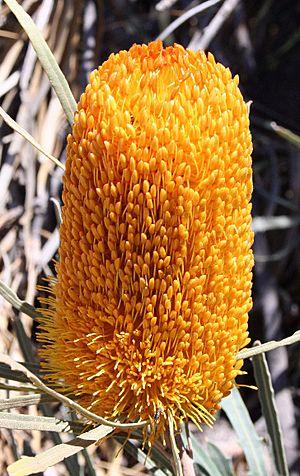Banksia benthamiana facts for kids
Quick facts for kids Banksia benthamiana |
|
|---|---|
 |
|
| Banksia benthamiana near Pithara | |
| Conservation status | |
| Scientific classification | |
| Genus: |
Banksia
|
| Species: |
benthamiana
|
Banksia benthamiana is a unique type of shrub that grows only in the south-west part of Western Australia. This plant is known for its long, hairy leaves, which often have small teeth along their edges. It also produces beautiful spikes of orange flowers.
Contents
What it Looks Like
Banksia benthamiana is a shrub that usually grows to be about 2 to 4 meters (6.5 to 13 feet) tall. Unlike some other plants, it does not have a special woody base called a lignotuber that helps it regrow after fires.
Its bark is rough and flaky, usually grey in color. The younger branches are covered with thick, rust-colored hairs. The leaves are long and narrow, typically measuring 10 to 25 centimeters (4 to 10 inches) long and 0.5 to 1 centimeter (0.2 to 0.4 inches) wide. Each leaf has a short stem, called a petiole, about 0.5 to 1.5 centimeters long.
Along the sides of the leaves, you can often find small teeth, about 1 to 2 millimeters long. Both sides of the leaves are hairy when they are young.
The flowers grow in a spike on a short side branch. This flower spike is usually 5 to 10 centimeters (2 to 4 inches) long and about 6 centimeters (2.4 inches) wide when the flowers open. Each flower has a hairy outer part called a perianth, which is about 2 to 2.4 centimeters long. It also has a smooth, curved pistil, which is the part that receives pollen, about 2.3 to 2.6 centimeters long.
Banksia benthamiana flowers from late November to January. After flowering, up to 130 smooth, furry seed pods, called follicles, can grow on each spike. These pods are narrow and oval-shaped, about 1 to 1.5 centimeters long and 0.3 to 0.5 centimeters high and wide.
How it Got its Name
The plant Banksia benthamiana was officially described for the first time in 1964. This was done by a botanist named Charles Gardner. He published his description in a scientific paper called the Journal of the Royal Society of Western Australia.
The first samples of this plant, known as "type specimens," were collected in January 1940 near a town called Dalwallinu. The second part of its scientific name, benthamiana, was chosen to honor George Bentham (1800–1884). He was a famous botanist who wrote a very important book about Australian plants called Flora Australiensis.
Scientists believe that Banksia benthamiana is closely related to another plant called B. ashbyi. B. ashbyi is a larger shrub with bigger leaves that have deeper cuts. It also has bright orange flowers and wider, more rounded seed pods. It might also be related to B. audax, which is a much smaller plant.
Scientists use different methods to figure out how plants are related. One method, called morphological cladistics, looks at the physical features of plants. Another method, molecular study, looks at their DNA. Both methods have helped scientists understand the family tree of Banksia benthamiana.
Where it Lives
This banksia plant is found in different small groups, or populations, between Mullewa and Kulja in Western Australia.
It typically grows on flat areas in shrubland, which is a type of land covered mostly by shrubs. Sometimes, it grows taller than the other plants around it. It prefers to grow in brownish-yellow sandy loam or clay-loam soil. This soil can sometimes be found over a hard, reddish rock layer called laterite. Many of the groups of these plants are small and can be found along the sides of roads. The areas where it grows usually get about 300 millimeters (12 inches) of rain each year.
Protecting the Plant
The Government of Western Australia's Department of Parks and Wildlife currently lists Banksia benthamiana as "Priority Four". This means that the plant is rare or close to being threatened. It needs to be watched carefully to make sure its populations stay healthy.
Plant Life and Nature
In 1985, volunteers who were studying banksias reported that they saw moths and birds helping to pollinate Banksia benthamiana. This means these animals help the plant reproduce by carrying pollen from one flower to another.
Growing it at Home
Banksia benthamiana is not very common in gardens. It's not the best choice for small gardens because it can grow quite tall. However, it can be grown in a large pot and grows quite quickly.
For this plant to grow well, it needs soil that is slightly acidic, deep, and sandy or gravelly. The seeds of Banksia benthamiana do not need any special treatment to sprout. They usually take about 19 to 42 days to germinate (start growing).


